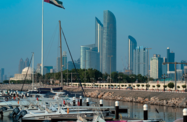Abu Dhabi’s economy expanded steadily in 2019, thanks in part to oil sector growth and the ongoing rollout of publicly backed economic stimulus plans.

The emirate is projected to record full-year growth of 2% in 2019, according to a report released in June by credit ratings agency Standard & Poor’s (S&P), slightly above 2018’s rate of 1.9%.
While this is below the Central Bank of the UAE’s forecast of 2.4% for the country, S&P’s projected growth rate is higher than the IMF’s 1.6% estimate for the broader UAE.
First quarter results underscore the continuing significance of the oil sector in the emirate, with the economy’s year-on-year (y-o-y) expansion of 5.7% being supported by a 12.8% y-o-y rise in oil GDP, according to figures from Statistics Centre - Abu Dhabi.
Oil activity is key to both short- and medium-term growth. S&P estimates that the economy will grow by an annual average of 2.5% through to 2022, underpinned by higher oil production. This could see GDP growth accelerate to 3% by 2022.
See also: The Report – Abu Dhabi 2019
Stimulus plans to drive non-oil growth
While a rebound in hydrocarbons activity drove growth in 2019, Abu Dhabi also continued to roll out economic stimulus plans designed both to boost the economy and to reduce dependence on oil.
As part of the Dh50bn ($13.6bn) Ghadan 2021 strategy, first announced in June 2018, in 2019 the emirate launched nine new initiatives to boost private sector development and small and medium-sized enterprise (SME) growth.
The initiatives include the establishment of a new scoring mechanism for industrial tariffs, geared towards enhancing the emirate’s competitiveness and supporting the development of the sector; new licences for tech businesses to operate in the emirate; and the launch of the SME Credit Guarantee scheme, through which the government will underwrite 75% of bank loans taken out by small local businesses, in a bid to boost credit to the sector.
Meanwhile, as part of efforts to stimulate innovation, in June the government launched a Dh4bn ($1.1bn) fund to support research and development (R&D), offering rebates on R&D spending and commercialisation costs.
In terms of more sector-specific initiatives, the Department of Culture and Tourism – Abu Dhabi launched a Dh600m ($163.4m) fund in July to finance projects and attract investment in the tourism and entertainment sector, an area with significant growth potential.
More broadly, the Abu Dhabi Department of Economic Development aims to increase the private sector’s contribution to GDP from 32% in 2019 to 37% by 2021, while the Ghadan 2021 programme seeks to reduce the share of hydrocarbons in the economy from 50% to 20%.
Container traffic expands amid logistics push
Abu Dhabi’s efforts to diversify the economy have also driven an expansion of activity at Khalifa Port, the emirate’s largest maritime facility.
The amount of container traffic handled at the port grew by 82.4% y-o-y in the first half of the year, to 1.1m twenty-foot equivalent units (TEUs).
Key to the increase was the decision by Switzerland-based shipping and logistics firm Mediterranean Shipping Company (MSC) to shift part of its regional activity to the port.
The move is part of a 30-year, $1.1bn deal, signed in May 2018, that will see MSC develop and operate a new container terminal at Khalifa Port. It is expected to add 2.8m TEUs of annual capacity by 2020.
This was followed in December 2018 by the inauguration of a new container terminal at Khalifa Port by China’s COSCO Shipping Ports (CSP) and Abu Dhabi Ports.
The CSP Abu Dhabi Container Terminal, which opened with an initial handling capacity of 1.5m TEUs, can be extended to 2.5m TEUs, and features the largest container freight station in the MENA region.
The increase in capacity and activity at the port aligns with broader government plans to position the emirate as a key regional transport and trade hub, with significant potential for growth in the logistics and trans-shipment sectors.


